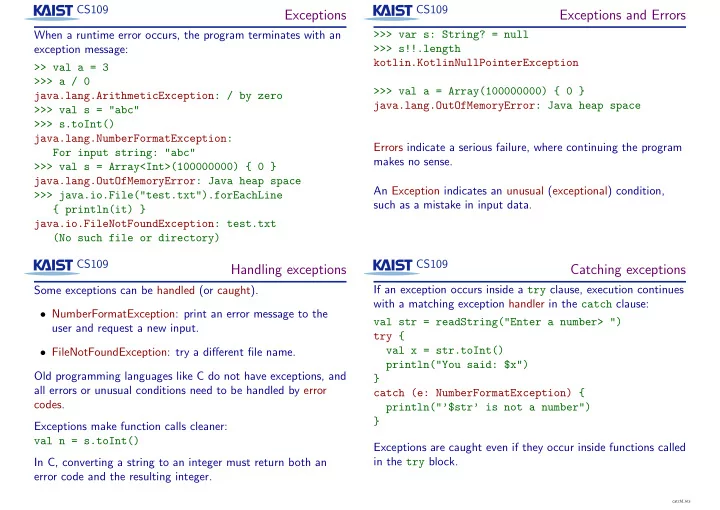

CS109 CS109 Exceptions Exceptions and Errors When a runtime error occurs, the program terminates with an >>> var s: String? = null exception message: >>> s!!.length kotlin.KotlinNullPointerException >> val a = 3 >>> a / 0 >>> val a = Array(100000000) { 0 } java.lang.ArithmeticException: / by zero java.lang.OutOfMemoryError: Java heap space >>> val s = "abc" >>> s.toInt() java.lang.NumberFormatException: Errors indicate a serious failure, where continuing the program For input string: "abc" makes no sense. >>> val s = Array<Int>(100000000) { 0 } java.lang.OutOfMemoryError: Java heap space An Exception indicates an unusual (exceptional) condition, >>> java.io.File("test.txt").forEachLine such as a mistake in input data. { println(it) } java.io.FileNotFoundException: test.txt (No such file or directory) CS109 CS109 Handling exceptions Catching exceptions If an exception occurs inside a try clause, execution continues Some exceptions can be handled (or caught). with a matching exception handler in the catch clause: • NumberFormatException: print an error message to the val str = readString("Enter a number> ") user and request a new input. try { val x = str.toInt() • FileNotFoundException: try a different file name. println("You said: $x") Old programming languages like C do not have exceptions, and } all errors or unusual conditions need to be handled by error catch (e: NumberFormatException) { codes. println("’$str’ is not a number") } Exceptions make function calls cleaner: val n = s.toInt() Exceptions are caught even if they occur inside functions called in the try block. In C, converting a string to an integer must return both an error code and the resulting integer. catch1.kts
CS109 CS109 Catching across function calls Handling exceptions If an exception occurs, the normal flow of control is fun test(s: String): Int = interrupted. Execution continues in the innermost catch block (s.toDouble() * 100).toInt() with a matching exception handler. fun show(s: String) { fun f(n: Int) = g(n) try { println(test(s)) fun g(n: Int) { } val m = 100 / n catch (e: NumberFormatException) { println("The result is $m") println("Incorrect input") } } try { } f(n) >>> show("123.456") } 12345 catch (e: ArithmeticException) { >>> show("123a456") println("I can’t handle this value!") Incorrect input } catch2.kts except1.kts CS109 CS109 Throwing exceptions Assertions When we detect an error in the input data, we can throw an Exceptions are used to detect errors in input data. exception ourselves: Assertions are used to detect errors in your program. if (n < 0) The statement: throw IllegalArgumentException() assert(condition) throws an AssertionError if condition is false. Exceptions are often used to detect errors in the input data. ... code A computing string s ... We can catch the exception at a suitable place in the program // if A is correct, then s is not empty and print an error message, or handle the problem in some assert(s.isNotEmpty()) other way. ... code B (using s) ... The assertion protects code B from errors in code A. Without the assertion, an error in A could cause a strange problem in B. Debugging could be difficult. except2.kts except3.kts
CS109 require require is a special form of assertion, that throws an IllegalArgumentException . It is used to protect a function from being used with incorrect arguments. fun factorial(n: Int): Long { require(n >= 2) assert(false) var result = 1L for (i in 1 .. n) result *= i return result } Again, require makes debugging easier. We do not need to search for a bug in factorial when the problem is in the code calling factorial .
Recommend
More recommend